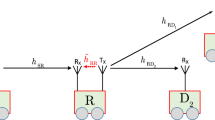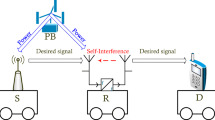Abstract
In this paper, we study the performance of a full-duplex (FD) relay system in vehicle-to-vehicle (V2V) communication. In this relay communication system, the communication link from the source node to the relay node can be modeled by Rayleigh fading or double (cascaded) Rayleigh fading distributions while the link from the relay node to the destination node is modeled by double Rayleigh fading distribution. Through the numerical calculation, we obtain the exact analytical expressions for the outage probabilities (OPs) and symbol error rates (SERs) in two cases, i.e. case A (the first hop is the Rayleigh fading channel and the second hop is double Rayleigh fading channel) and case B (two hops are the double Rayleigh fading channels). From these obtained mathematical expressions, the impacts of the distances between the communication nodes and the residual self-interference caused by the imperfect self-interference cancellation at the FD relay are studied. In addition, the effects of path loss exponent and the transmission power at the FD relay are also investigated. Numerical results show that the system performance in terms of OP and SER in the case of double Rayleigh fading channels is significant lower than the case of Rayleigh fading channels. Monte-Carlo simulations are conducted to validate the correctness of these numerical results.







Similar content being viewed by others
References
Li QC, Niu H, Papathanassiou AT, Wu G (2014) 5G network capacity: key elements and technologies. IEEE Veh Technol Mag 9(1):71–78
Sabharwal A, Schniter P, Guo D, Bliss DW, Rangarajan S, Wichman R (2014) In-band full-duplex wireless: challenges and opportunities. IEEE J Sel Areas Commun 32(9):1637– 1652
Bharadia D, McMilin E, Katti S (2013) Full duplex radios. In: ACM SIGCOMM computer communication review, vol 43, no 4. ACM, pp 375–386
Abbasi O, Ebrahimi A (2018) Cooperative NOMA with full-duplex amplify-and-forward relaying. Trans Emerg Telecommun Technol 29(7):e3421
Chen DH, He YC (2018) full-duplex secure communications in cellular networks with downlink wireless power transfer. IEEE Trans Commun 66(1):265–277
Li C, Chen Z, Wang Y, Yao Y, Xia B (2017) Outage analysis of the full-duplex decode-and-forward two-way relay system. IEEE Trans Veh Technol 66(5):4073–4086
Nguyen BC, Tran XN, Tran DT (2018) Performance analysis of in-band full-duplex amplify-and-forward relay system with direct link. In: 2018 2nd international conference on recent advances in signal processing, telecommunications and computing (SigTelCom). IEEE, pp 192–197
Choi D, Lee JH (2014) Outage probability of two-way full-duplex relaying with imperfect channel state information. IEEE Commun Lett 18(6):933–936
Hoang TM, Van Son V, Dinh NC, Hiep PT (2018) Optimizing duration of energy harvesting for downlink NOMA full-duplex over Nakagami-m fading channel. In: AEU Int J Electron Commun, vol 95, pp 199–206
Gonzalez GJ, Gregorio FH, Cousseau JE, Riihonen T, Wichman R (2017) Full-duplex amplify-and-forward relays with optimized transmission power under imperfect transceiver electronics. EURASIP J Wireless Commun Netw
Koc A, Altunbas I, Basar E (2017) Two-way full-duplex spatial modulation systems with wireless powered AF relaying. IEEE Wireless Commun Lett
Nguyen NP, Ngo HQ, Duong TQ, Tuan HD, da Costa DB (2017) Full-duplex cyber-weapon with massive arrays. IEEE Trans Commun 65(12):5544–5558
Zhang T, Cai Y, Huang Y, Duong TQ, Yang W (2017) Secure full-duplex spectrum-sharing wiretap networks with different antenna reception schemes. IEEE Trans Commun 65(1):335– 346
Deng Y, Kim KJ, Duong TQ, Elkashlan M, Karagiannidis GK, Nallanathan A (2016) Full-duplex spectrum sharing in cooperative single carrier systems. IEEE Trans Cognitive Commun Network 2(1):68–82
Nguyen NP, Kundu C, Ngo HQ, Duong TQ, Canberk B (2016) Secure full-duplex small-cell networks in a spectrum sharing environment. IEEE Access 4:3087–3099
Doan XT, Nguyen NP, Yin C, Da Costa DB, Duong TQ (2017) Cognitive full-duplex relay networks under the peak interference power constraint of multiple primary users. EURASIP J Wirel Commun Netw 2017(1):8
Tam HHM, Tuan HD, Nasir AA, Duong TQ, Poor HV (2017) MIMO energy harvesting in full-duplex multi-user networks. IEEE Trans Wirel Commun 16(5):3282–3297
Nguyen VD, Duong TQ, Tuan HD, Shin OS, Poor HV (2017) Spectral and energy efficiencies in full-duplex wireless information and power transfer. IEEE Trans Commun 65(5):2220– 2233
Hoang TM, Tan NT, Cao NB (2017) Outage probability of MIMO relaying full-duplex system with wireless information and power transfer. In: 2017 conference on information and communication technology (CICT). IEEE, pp 1–6
Nguyen BC, Hoang TM, Tran PT (2019) Performance analysis of full-duplex decode-and-forward relay system with energy harvesting over Nakagami-m fading channels. AEU Int J Electron Commun 98:114–122
Ai Y, Cheffena M, Mathur A, Lei H (2018) On physical layer security of double rayleigh fading channels for vehicular communications. IEEE Wireless Commun Lett
Campolo C, Molinaro A, Berthet AO, Vinel A (2017) Full-duplex radios for vehicular communications. IEEE Commun Mag 55(6):182–189
Biswas S, Tatchikou R, Dion F (2006) Vehicle-to-vehicle wireless communication protocols for enhancing highway traffic safety. IEEE Commun Mag 44(1):74–82
Duy TT, Alexandropoulos GC, Tung VT, Son VN, Duong TQ (2016) Outage performance of cognitive cooperative networks with relay selection over double-Rayleigh fading channels. IET Commun 10(1):57–64
Chen Y, Wang L, Ai Y, Jiao B, Hanzo L (2017) Performance analysis of NOMA-SM in vehicle-to-vehicle massive MIMO channels. IEEE J Sel Areas Commun 35(12):2653–2666
Wu J, Xiao C (2007) Performance analysis of wireless systems with doubly selective Rayleigh fading. IEEE Trans Veh Technol 56(2):721–730
Seyfi M, Muhaidat S, Liang J, Uysal M (2011) Relay selection in dual-hop vehicular networks. IEEE Signal Process Lett 18(2):134–137
Cheng Yin EG-P, Yang L (2018) Outage probability of vehicular networks under unreliable backhaul. [Online]. Available: http://eudl.eu/doi/10.4108/eai.19-12-2018.156077
Mao CX, Gao S, Wang Y (2018) Dual-band full-duplex Tx/Rx antennas for vehicular communications. IEEE Trans Veh Technol 67(5):4059–4070
Yang M, Jeon SW, Kim DK (2018) Interference management for in-band full-duplex vehicular access networks. IEEE Trans Veh Technol 67(2):1820–1824
Salo J, El-Sallabi HM, Vainikainen P (2006) Statistical analysis of the multiple scattering radio channel. IEEE Trans Antennas Propag 54(11):3114–3124
Salo J, El-Sallabi HM, Vainikainen P (2006) Impact of double-Rayleigh fading on system performance. In: 2006 1st International symposium on wireless pervasive computing. IEEE, p 5
Hong S, Brand J, Choi JI, Jain M, Mehlman J, Katti S, Levis P (2014) Applications of self-interference cancellation in 5G and beyond. IEEE Commun Mag 52(2):114–121
Li X, Tepedelenlioglu C, Şenol H (2017) Channel estimation for residual self-interference in full-duplex amplify-and-forward two-way relays. IEEE Trans Wirel Commun 16(8):4970–4983
Yang K, Cui H, Song L, Li Y (2015) Efficient full-duplex relaying with joint antenna-relay selection and self-interference suppression. IEEE Trans Wirel Commun 14(7):3991–4005
Garcia AL (2008) Probability, statistics, and random processes for electrical engineering
Goldsmith A (2005) Wireless communications, Cambridge, Cambridge University Press
Jeffrey A, Zwillinger D (eds) (2007) Table of integrals, series, and products. Elsevier, Amsterdam
Abramowitz M, Stegun IA (1972) Handbook of mathematical functions with formulas, graphs, and mathematical tables. National Bureau Standards Appl Math Series 55:1076
Author information
Authors and Affiliations
Corresponding author
Additional information
Publisher’s Note
Springer Nature remains neutral with regard to jurisdictional claims in published maps and institutional affiliations.
Appendices
Appendix A
This appendix gives detailed derivations of the outage probability of FD-V2V communication system in case A and case B corresponding to one and two communication links are double Rayleigh fading channels, respectively.
Let us start with the Rayleigh fading channel, the probability density function (PDF) and cumulative distribution function (CDF) of the instantaneous channel gain |g|2 are given by
where \({\Omega } = \mathbb {E}\{|g|^{2}\}\).
In the case of double Rayleigh fading channels, the instantaneous channel gain |h|2 is the multiplication of two independent variables |g1|2 and |g2|2, where |g1|2 and |g2|2 are the instantaneous channel gains of the Rayleigh fading channels between two vehicles [32]. Thus, we have the CDF of |h|2 as
From Eq. 19, we can obtain the PDF of |h|2 as
where \({\Omega }_{1} = \mathbb {E}\{|g_{1}|^{2}\}, {\Omega }_{2} = \mathbb {E}\{|g_{2}|^{2}\}\).
From the PDF and CDF functions of the instantaneous channel gains given in Eqs. 18, 17, 19, and 20, we can derive the OP in the case A and B as follows.
1.1 Case A
To derive the OP of the system in this case, we firstly derive the CDF of γR and γD. Since the S →R link is Rayleigh fading channel, its instantaneous channel gain is defined as |hSR|2 = |g1|2 and the average channel gain \({\Omega }_{1}=\mathbb {E}\{|g_{1}|^{2}\}\). Then, the CDF of γR can be given by
Meanwhile, the R →D link is double Rayleigh fading channels, thus |hRD|2 = |g3|2|g4|2 and \({\Omega }_{3}=\mathbb {E}\{|g_{3}|^{2}\}\), \({\Omega }_{4}=\mathbb {E}\{|g_{4}|^{2}\}\). Consequently, the CDF of γD can be calculated as
Based on Eq. 12, we have the OP of the FD-V2V communication system in the case A as in Eq. 9.
1.2 Case B
Similar to case A, we have
where |hSR|2 = |g1|2|g2|2, \({\Omega }_{1}=\mathbb {E}\{|g_{1}|^{2}\}\) and \({\Omega }_{2}=\mathbb {E}\{|g_{2}|^{2}\}\). Based on the similar calculations as in Eq. 22, we have
Using Eq. 12, the OP of the FD-V2V communication system in the case B is derived as in Eq. 10. The proof is completed.
Appendix B
The section gives detailed derivations of the SER of the FD-V2V communication system in case A and case B.
1.1 Case A
From Eq. 16, substituting F(x) by OP in Eq. 9, we have
For the first integral in Eq. 25, using [38, Eq.3.361.2], we have
For the second integral in Eq. 25, using [38, Eq.6.643.3], we have
Substituting (26) and (27) into Eq. 25, we obtain the SER in case A as Eq. 14.
1.2 Case B
Similar to case A, we have
The first integral in Eq. 28 can be easily obtained as in Eq. 26. For the second integral, setting z = e−bx/2 results in \(x=-\frac {2}{b}\ln z\). Hence, we can rewrite the second integral as
Using the Gaussian-Chebyshev quadrature method in [39], we can obtain J as
Then, the SER in case B can be obtained as in Eq. 15. The proof is completed.
Rights and permissions
About this article
Cite this article
Nguyen, B.C., Tran, X.N., Hoang, T.M. et al. Performance Analysis of Full-Duplex Vehicle-to-Vehicle Relay System over Double-Rayleigh Fading Channels. Mobile Netw Appl 25, 363–372 (2020). https://doi.org/10.1007/s11036-019-01291-x
Published:
Issue Date:
DOI: https://doi.org/10.1007/s11036-019-01291-x




